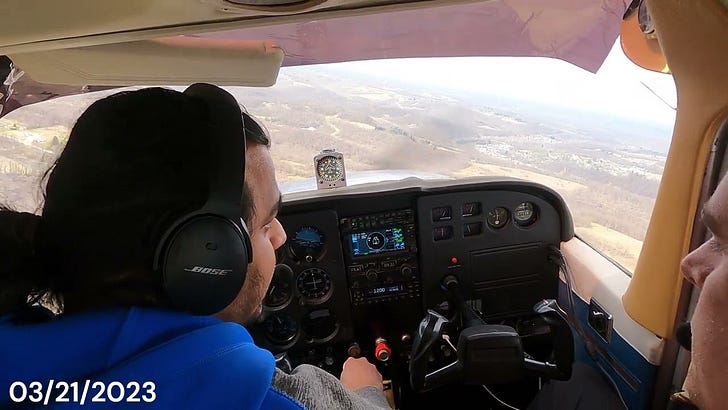“ I need you to demonstrate control today. Thats everything. My primary focus is control in all these legs, including the Base. ”
- Drew, before today’s lesson.
After last traffic patterns lesson, Drew and I came up with a plan to specifically work on my Downwind to Base to Final transition. The plan was to practice it at an altitude. Then while it is fresh, exercise it in actual traffic patterns. As I executed upon that plan, I was also paying attention to some of my habits and behavior - especially regarding Sight Picture, throtte adjustment, and flaps. Below are my observations from today's lesson.
1. Appropriate throttle and flaps adjustments
As I got onto the Downwind and leveled the flight, reducing the throttle input between 1700 and 2000 RPM, was the correct input, for that leg of the flight. As I observed the airspeed and altitude, it was in much better control. Adding flaps in 10 degrees increment at the right time also helped the airspeed not-getting-out-of-control. So the correct order of actions would be -
As I approach TPA, at around 2050 ft. level the wings (Of course after the Downwind turn is complete !). That way I would let the plane climb itself up to TPA of 2200 ft.
Downwind - it is imperative that I maintain straight and level flight during the entire downwind leg. I have a tendency to let the nose drop when I reduce throttle. Maintaining straight leveled flight for the entire Downwind helped keep airspeed in check drastically.
Base and beyond - Until I started turning on the Base turn, I felt like time has slowed down, and I had all the time in the world. As soon as I turned on the base, time sped up sharply. Due to that, I have been acting in urgent haste, which is really uncalled for.
First and foremost - I forgot the basic order of actions - First AVIATE, then NAVIGATE, then COMMUNICATE. What that means is that, get to the Base, then level the wings, or continue to turn towards the final based on wind conditions, make sure you are in the Base leg, and then call the radio about where you are.
What I was doing was I was communicating first - “ Turning downwind to Base, runway 26, 680 ”. This is a behavior change at core, since all my life I have been training me brain that way - be it driving, or even the most mundane work.
For example, let’s say, you arrive at an intersection while driving. You need to turn right. You give your indicator and then you turn, right?!?!? (pun intended). Here, what’s expected is you turn right, and then to tell - “ Hello!! I just turned right ”.
But, I am starting to realize the implications of it first hand. In my case, it certainly would minimize the task saturation. There are many more reasons to do so, but I am sticking to challenges specific to me :).
Second - I need to extend my base leg further. Consistently I was finishing my base tum well-short of extended center-line of the runway. That would introduce more tasks to fix my final approach. Extending my base leg a bit more would make my final approach a lot more stable.
2. Seeing is believing, and Believing in seeing
This was the biggest realization of the day for me. I realized how hopelessly dependent I was on the instruments, and not believing in MY SIGHT PICTURE. This needs to be a crucial fix because
SIGHT PICTURE NEVER LIES!!!
INSTRUMENTS LIE ALL THE TIME, EVEN THE EFDs!!!
Instruments are laggy, and always tell you the story of the past. Sight picture tells you immediately if you are climbing up, diving at ground, or flying straight and level. I need to use instruments to validate my action, not dictate my action. What I need to do is to START TRUSTING MY EYES OVER INSTRUMENTS. Sight Picture tells me everything I need to know. Trust that, and then check the instruments to make sure it is correct. Not the other way around. Being a data guy, that is again something that goes against what I have trained my entire adult life for. but that is the right way for a VFR pilot.
Sight picture data triumphs over instrument data in real-time-decision-making.
You can see that the difference between sight picture on both days is slight, but significant. The control over airspeed, descent rate - the difference felt like night and day. My airspeed on the base turn never exceeded out of flaps range on last lesson. On previous lesson, it almost everytime exceeded outside flaps range.
These fixes are not going to be easy from what I know about myself. But, identifying them and starting a change in behavior is a big first step. Slowly, I am starting to realize how uniquely skilled the aviators are, rather aviators need to be !!!
I also think in past few lessons, communication between Drew and I has improved in terms of quality, simply based on how I feel after the lesson. I think he is learning how to teach things to ME, what references I understand and how I grasp things. I feel that subsequent lessons are going to show big improvement in my control.



